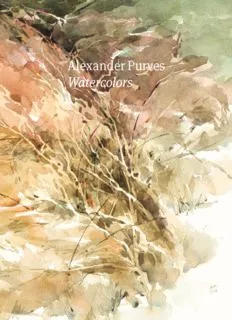
Alexander Purves Watercolors PDF
Preview Alexander Purves Watercolors
Alexander Purves Watercolors Alexander Purves Watercolors Alexander Purves Watercolors Essay by Ruth Miller This publication accompanies an exhibition at the Henry Koerner Center for Emeritus Faculty, Yale University October 9 to December 18, 2017 Dedicated to Drika Agnew Purves February 2, 1940 – September 19, 2017 Exhibition open by invitation or appointment; call 203-432-8227 Copyright © 2017 by Henry Koerner Center for Emeritus Faculty, Yale University. All rights reserved. ISBN 0-9767908-9-0 Foreword One might expect an architect to draw, and indeed, Professor Alexander Purves studied drawing with Josef Albers as a Yale undergraduate. For fourteen years he has taught an intensive four-week drawing seminar, in Rome, for graduate students of the Yale School of Architecture (with his colleague Stephen Harby). In Purves’s view, drawing is a critical skill for an architect: “If you really want to see a building, you should draw it. Drawing forces you to look — and to look with precision and with a sense of inquiry.” For most of us, drawing and watercolor would seem to be very different arts and require somewhat different skills. However, I suspect that Alec sees a rock formation in his watercolor in a way not so dissimilar from the building he sees in his drawing; that is, he sees it with the eye of an architect. In any case, it is my expectation that as we live with his watercolor exhibition in the Koerner Center this fall and hear him talk about his art, we will gain a deeper understanding of how this architect perceives form and color. I want to thank Alec for sharing his art, Ruth Miller for her essay for the catalogue, David Baker for editing, Chika Ota for design, GHP for preparing the images and printing the catalogue, and John Gambell for overall management of the catalogue production. Gary L. Haller, Director 5 Rock Reclining 2005 (15 x 22 in.), private collection The Watercolors of Alexander Purves I’ve long admired the accomplished watercolors of Alexander Purves, and over the years my appreciation has continued to grow, together with my pleasure and gratitude for the valuable lessons they bring. They are thoughtful, contemplative, modest, sensitive, generous, and knowledgeable, as is the man. Alec is an architect, in my mind a modern-day John Ruskin. He is an esteemed teacher as well as a master of the medium of watercolor. Watercolor is a medium which has been labeled as a difficult one, but in Alec’s hands it behaves brilliantly — and with such apparent ease that one is convinced that it is perhaps the most manageable medium. Architecture, the mother of all of the arts, I imagine to be the most challenging and difficult of human endeavors. I think of Alec’s watercolors in this way. They are like a form of flat architecture — the role the parts play to the whole, the sense of scale, the awareness of light, the measured development of his form, the order and timing of how all of these components build a space, both interior and exterior. One thinks of Cézanne’s late watercolors, or Morandi’s drawings, when considering Alec’s use of the white of the paper. His method makes one think of stone that is carved or how an architect uses space. The white of the paper is often volume. It is like a foundation, a surface to build from. The white of the paper becomes one of the most active ingredients of the work, not a passive surface to fill, but an active foundation. 7 I think of his thickets, rocks, rivers and forests, palm trees and ferns — motifs and places he loves and returns to over and over, finding form, light, and order. He brings forth their unique characters. Forms become concrete. In the best of his work a kind of alchemy happens, joining his vision and medium to his subject, expressing perfect balance, harmony, and order. I especially like the rocks and the thickets. I feel that when he’s painting and looking at brambles from his studio window, they are so complicated that he’s having to explain to himself how he is seeing them, not only what he is seeing. They become more abstract and free because of this. What often happens when someone comes to painting from another discipline is that they approach making painting with technique alone. They miss the point. They are putting down, naming what they are seeing, lost in the specifics of subject and detail, not involved in the contemplative thing of how they are seeing. And this is why I admire Alec’s work most of all. Ruth Miller Washington Depot, Connecticut August 3, 2017 8
Description: